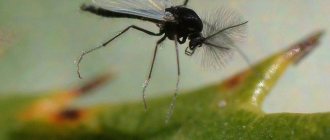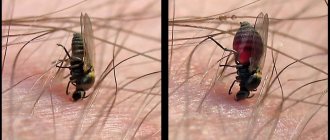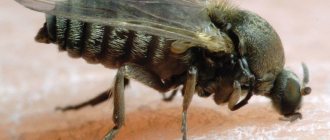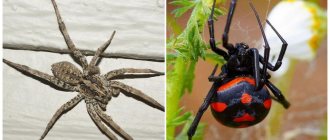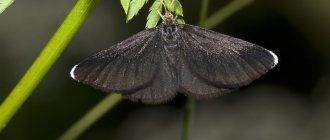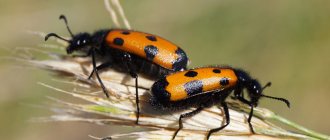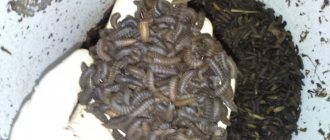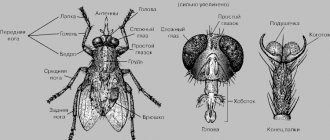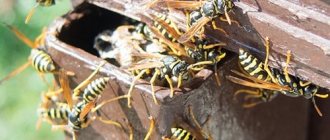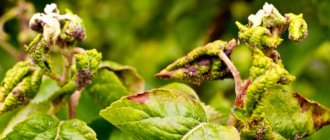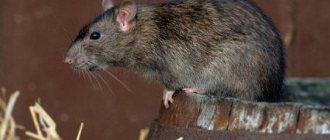Almost everyone knows who midges are. Insects that look like humpback mosquitoes are often encountered during the warm season. It is surprising that even such small creatures can cause a lot of trouble to a person, from the possibility of flying into a plate of food or a glass of drink, to the ability to carry an infection and bite. After all, there is also a type of pests whose food is the blood of mammals. However, before talking about what midges feed on, it is worth considering the characteristic structural features of these annoying pests.
Midges - description, structure and characteristics
The body length of midges varies from 1.2 to 6 mm. The smallest species live in the tropics, the largest are common in the northern temperate and subpolar latitudes.
There are 3 main sections in the structure of midges: head, chest and abdomen. The rounded head of females has a wide forehead; in males it is narrower. The antennae of midges consist of 11 (sometimes 9 or 10) segments; they are very thin, rope-like and covered with short hairs. The color of the antennae varies from dark yellow and brownish to dark gray and black. The antennae of females are thicker and shorter than those of males, and also have a slight flattening and taper towards the end.
The eyes of the midge are faceted, in males they usually touch along the frontal seam, in females they are separated by the forehead. Horizontally, the eyes of males are divided into a larger upper part, where the large facets are located, and a smaller lower part, where the small facets are located. In females, all facets are the same size, and their number exceeds the number of facets in males. Additional simple eyes are not developed in midges.
Photo by: nadia. Taken from the site: diptera.info
The chest of insects is strongly convex. Hairs grow on the back, and there may also be various spots of dark or silver color. The color and shape of the spots vary among different species of midges.
The abdomen of midges is oval-shaped, slightly pointed towards the end and consists of 11 segments. The dorsal part of the first segment protrudes upward and backward, forming a kind of collar covered with a brush of long hairs.
Midges have well-developed halteres, which are club-shaped. The halteres are paired appendages of the thoracic segments of insects; in midges they are located on the metathorax and are modified wings. During flight, they help the insect maintain balance, vibrate and make a characteristic sound. That's why insects buzz. The stalk of the haltere in midges is of medium length, at the end of the club there is a slight impression. The color of the halteres varies from white-yellow, yellowish and ocher to brown and black. The club is usually lighter than the stalk. In addition, males have darker and brighter halteres than females.
Photo by: nadia. Taken from the site: diptera.info
The wings of midges are wide, round-oval, transparent, with longitudinal venation, length from 1.4 to 6 mm. The surface of the wings is covered with small tubercles. When at rest, the wings fold horizontally, covering one another.
Photo by: nadia. Taken from the site: diptera.info
The oral appendages of midges consist of palps and a complex proboscis of the piercing-sucking type. The proboscis is short and thick, it consists of an upper lip and epipharynx, hypopharynx, 2 mandibles (upper jaws), 2 maxillae (lower jaws) and a lower lip. The upper lip, mandibles and maxillae of blood-sucking females have teeth of the tearing-cutting type. In males and females that do not drink blood (for example, Prosimulium alpestre), the teeth are replaced by hairs. The maxillary palps consist of 4-5 segments; on the third segment a special sensory organ is developed that performs sensory functions. The palps are used by midges to orient themselves on the body of a person or animal when choosing a place for an injection. The upper lip also has the same functions, but first of all it serves to pierce the skin of the victim. After the bite, the wound is sawed off at the ends of the mandibles, which move from top to bottom. Maxillae, when immersed in the wound, tear the tissues and walls of the victim’s blood vessels. Next, the midge immerses the upper lip, epipharynx and hypopharynx into the wound and drinks blood. In the hypopharynx there is a channel through which saliva enters the wound, preventing blood clotting. The lower lip has a sensitive function and is used for licking. Like other bloodsuckers, midges pass water and liquid carbohydrate food through the esophagus into the crop, and blood flows directly into the midgut.
Midges have 3 pairs of fairly powerful limbs, each consisting of a coxa, trochanter, femur, tibia and a five-segmented tarsus. The paws of midges are equipped with claws: in males, at their base there is a wide cup-shaped tooth, in females the claws can be simple (short or long) or also have a tooth (large or small). Most often, the limbs of midges are black, although in some varieties individual segments of the legs may be yellowish or brown in color or covered with silvery spots. The coloring, pubescence and shape of the limbs depend on the type of midge.
Midge under a microscope. Photo credit: United States Department of Agriculture, Public Domain.
Where do midges live?
Midges live on almost all continents, with the exception of Antarctica and the Sahara Desert. These small insects live in North and South America, Australia, Mediterranean countries, Russia, Central and Central Asia, Japan, Indochina, India, Thailand, Sri Lanka, Kazakhstan and Taiwan, the Far East and the Caucasus, the Baltic states and in North Africa.
Particularly many midges are found in taiga regions, in deciduous forests with high humidity, and also near water bodies. The presence of nearby water is a necessary condition for the habitat of midges, because three of the four life stages of development (egg, larva, pupa) of these insects take place in water bodies or in the immediate vicinity of them. Only adult imagoes live on land.
Author of the photo: Semyonova Maria
Varieties
You don't need to be a biologist to know that individuals of each species may have external differences, according to which they are divided into subspecies.
The insects in question have their own varieties.
Different hereditary forms of the Drosophila fly
Drosophila are:
- Black Drosophila.
- Fruit Drosophila.
- Flightless Drosophila.
Whitefly happens:
- Greenhouse whitefly.
Whiteflies - Citrus whitefly.
- Strawberry whitefly.
- Cabbage whitefly.
- Tobacco whitefly.
Sciarids are also divided into subspecies:
- Licoriella.
- Bradysia.
These two species can most often be found in Russia, where 96 subspecies of these insects have been recorded.
What do midges eat?
The nutrition of these insects depends on gender. The females of most species of midges are a large component of midges (in addition to mosquitoes and midges) and prefer to drink blood, attacking people, animals or birds. With their painful bites, they cause a lot of unpleasant sensations in the form of itching, local redness, swelling of the skin and even serious allergic reactions. Cows, horses, sheep, goats, roe deer, deer, buffalo, ducks, chickens, turkeys, and geese become victims of annoying midges. But dogs and cats practically do not suffer from midge bites.
Male midges are avid vegetarians and feed exclusively on nectar and plant juices. Among midges there are also completely non-blood-sucking species.
Photo by: Jarmo Holopainen
Folk recipes
At home, traditional medicine recipes can be used to relieve swelling after a midge bite, eliminate itching and prevent infection of wounds:
- Baking soda and vinegar have worked well as a means to relieve swelling. To do this, you need to prepare a soda solution, moisten a gauze bandage with it and apply it to the affected skin. Soda paste will help eliminate swelling in a few hours. To prepare it, soda must be mixed with water to the consistency of a thick paste. Apply the resulting substance periodically to damaged skin.
- Laundry soap is a universal remedy for redness, swelling and itching. Soap foam is applied to the swollen area and washed off after drying.
- If there are no medications at home, swelling can be eliminated using any product containing menthol. In critical situations, the use of toothpastes and mouth rinses is allowed.
- Cold compresses are suitable to relieve itching and swelling after bites. Frozen meat, ice cubes, cold water, in short, everything you can find in the refrigerator is applied to the swollen areas.
- In nature, you can provide emergency assistance to yourself or your child using a plantain leaf. Apply the pre-washed sheet to the affected area and attach it with a bandage. Dandelion leaf also has the effect of eliminating swelling.
- You can eliminate the discomfort after a midge bite using potatoes. To do this, apply a cut of a peeled tuber, juice or grated potato to the damaged skin.
- Applications of boric alcohol or an aqueous solution of boric acid will relieve itching and have an antiseptic effect.
- Onions are a recognized folk remedy for relieving pain and reducing swelling after a housefly bite. The onion should be chopped, wrapped in gauze and applied to the bite site.
Types of midges, names and photos.
Today, approximately 1,800 species of midges are known. Below is a description of several varieties.
- Ornamented midge (Odagmia ornata)
The length of the insect is from 3 to 4.5 mm. A silver-colored border is visible on the back. The coloring of the legs, antennae and abdomen depends on the subspecies. The body length of the larva is 6-11 mm (depending on the subspecies), the size of the pupa is 3-5 mm. Different subspecies of the ornate midge live throughout the Palearctic, north to Greenland, Novaya Zemlya and the outskirts of Europe and Asia, south to the Mediterranean and southern India, and is also found in North America.
Taken from: science.mnhn.fr, CC BY-NC-ND 4.0
- Horse midge ( Wilhelmia equina)
Presented in several varieties. The length of the midge reaches 2.5-4 mm. The back and abdomen are covered with silvery-golden hairs; males have silver spots on the shoulder fields. The body length of the larvae is 5-7 mm. In its posterior sucker there are 80-100 rows of hooks with 17-24 hooks in each row. The length of the pupa varies from 2.6 to 4 mm depending on the subspecies of the midge; the cocoon has a shoe-shaped shape. The habitat of the horse midge extends from the Kola Peninsula and Karelia to Kamchatka. The southern boundaries of the range have not been determined. Larvae and pupae are distributed in different rivers along the course and can live even in heavily polluted water bodies. Preference is given to bodies of water with vegetation. Females are bloodsuckers and attack people and animals. In horses, accumulations of midges can be seen in the ears. During the year, one (in the northern regions) or several (in the south) generations of horse midges develop.
Photo credit: JC Schou. Taken from: www.biopix.com
- Boophthora sericata
The body length of the midge is 3-3.5 mm. A pattern in the form of silver stripes is noticeable on the back of males. Females have a yellow color on their legs. The size of the larva is 6-7 mm, its color is whitish-yellow. The length of the pupa is 3-4 mm, the cocoon is simple, opaque. This type of midge lives in the European part of Russia and Eastern European countries. Midges develop in rivers and channels of large rivers that are silted and overgrown with vegetation.
Taken from: science.mnhn.fr, CC BY-NC-ND 4.0
- Tundra midge (Schoenbaueria pusilla)
The length of males is from 2.5 to 3 mm. The tentacles are short and thin. The back is velvety black, has a silvery tint on the sides and back, and is covered with sparse golden hairs. The abdomen is brownish-black on top, with dark hairs. The legs are black, the halteres are brown, darker at the base.
Female tundra midges are about 3 mm long and have black-brown tentacles and antennae. The forehead and crown are grayish, covered in dense hairs. There are no silvery spots on the back of females; the back itself is black and gray, covered with silvery hairs. The halteres are light yellow. The front veins of the wings are white and yellow. The legs of the female midge are brown-black. The claw is small, with a thickening at the base. The abdomen is black above, dark yellow below, covered with sparse hairs.
The dimensions of the larva are 4.5-6 mm, its color is yellow-white, the dorsal side has transverse brown stripes. In the posterior sucker of the larva there are 70-72 rows of hooks, 11-13 hooks in each row. The length of the light yellow pupa is from 2.5 to 3 mm, the cocoon is simple, with loose weaving, without windows on the sides. Tundra midges are common in the northern regions, from the Kola Peninsula to the Yenisei River basin. Mass pupation occurs in June-July. The flight of adult individuals is observed from July to the first half of September. The tundra midge is a vicious bloodsucker that attacks people and animals.
- Short-palmed midge (Simulium morsitans)
The length of the adult is approximately 3 mm. The body is black, but there are silver spots on the back. The length of the larva is from 5.5 to 6 mm, the pupa is from 2.8 to 3.6 mm. This species of midges lives en masse from Karelia and the Arkhangelsk region up to the Moscow region and the territory of Transbaikalia. The habitat depends on the subspecies.
Taken from: www.boldsystems.org
- Silver midge (Simulium argyreatum)
The length of an adult insect is from 3.5 to 3.8 mm. Narrow silvery spots are visible on the back of males; these spots are dark on females. The antennae and palps are black, although in females the antennae may have a brownish tint. The limbs of males are mostly black, although there is a silver spot on the middle tibia, and the hind tibia has a yellowish tint. The legs of females are brownish-black, with silvery spots on the outer side of the fore and middle tibia, and also with a light yellowish tint at the base of the hind tibia. The halteres of females are yellowish-white. The length of the larva is from 7 to 8.5 mm, the size of the pupa is approximately 4 mm. The cocoon is simple, with an edging along the front edge. Silver midges live in Russia, North America and Western Europe. They inhabit small, overgrown, silted rivers in the forest zone, and in the tundra in the north. Adults are found from early June to September, depending on latitude. Silver midges are vicious bloodsuckers that attack people in the taiga and tundra zones.
Photo by: A. Renz
- Light-fronted midge (Simulium noelleri)
The length of the midge is about 4 mm. The antennae of males are black, the limbs are also black with a lighter shade at the junction of the femur with the tibia, as well as on the first segment of the hind tarsus. The antennae of females are light yellow at the base. The female mandibles are evenly sloping and serrated on both sides. A bright silver pattern is visible on the back. The limbs of females are brown-black, with a lighter shade in some places. The size of the light-fronted midge larva varies from 7 to 9 mm, its color can be red or gray-yellow. The large fan of the larva contains 47-57 setae. The rear sucker has 68-80 rows of hooks with 10-15 hooks in each row. The length of the pupa is 4 mm, the cocoon has loose weaving, with numerous holes on the sides and top. Light-fronted midges live over a vast territory that extends from the countries of northeastern Europe east through Russia to Transbaikalia. In the south, the range reaches the middle of the European part of Russia.
Taken from: www.biodiversity.ubc.ca
Reproduction of midges
The life cycle of midges consists of 4 phases:
- Egg
- Larva
- Doll
- Imago (adult)
After fertilization by a male, the female simply needs blood for normal growth and maturation of eggs. With sufficient nutrition and favorable weather conditions, the eggs will fully ripen within 5-7 days; otherwise, the laying process may be delayed for up to three weeks. The female midge lays eggs in one layer in rows or groups of 50-100 pieces each, gluing the eggs together with a special secretion. Sometimes several females of the same or even different species lay eggs in one place. Midge eggs are laid on a constantly wet substrate next to a body of water, on stones, snags or vegetation protruding above the surface or completely submerged in water. The development of eggs, and then larvae and pupa, occurs in running water.
Midge eggs can have a rounded-triangular or rounded-rectangular shape, resembling an oval. The egg shell is very thin, sometimes translucent, and absolutely smooth. The length of the eggs varies from 0.15 to 0.4 mm. The color of the newly laid clutch is light ocher, then the eggs begin to darken, and their color becomes dark brown.
Taken from: www.researchgate.net
The midge larva is worm-shaped and consists of 11 segments. The color of the larva is light yellow or ocher, interspersed with greenish, brown or brown spots. The thoracic region of the body is noticeably thickened and equipped with a kind of “leg” for movement. The posterior end of the body has a strong swelling and a special organ (the so-called sucker) with numerous hooks, with the help of which the larva fixes its position. The ventral part of the body is often flattened.
The head of the larva is large, separated from the body by a clear bridge, and is most often darker in color than the body, often black. On the head of the larva there are developed long antennae, a mouthparts with a pair of powerful mandibles, as well as special chitinous formations - fans, which help the larva to filter food consisting of plankton and algae. In addition, the larvae have well-developed arachnoid glands that secrete a secretion with which they can move. But basically their lifestyle is semi-sedentary.
The midge pupa is completely, and sometimes only partially, covered with a cocoon, which has a round exit hole - through which the breathing process occurs, carried out with the help of respiratory threads. The cocoon is woven from spider threads secreted by the larva and can be of different shapes: hut-shaped, shoe-shaped, boot-shaped or goblet-shaped. The body of the pupa is sometimes covered with hairs, short bristles, various growths resembling plaques, tubercles, tiny cones, spines or cylinders.
During its development, the midge pupa does not move or feed: it only cares about a comfortable water temperature and oxygen flow. After one to two weeks, an adult is born.
Photo credit: Solito de Solis Michel-Marie, CC0
Depending on the species and temperature conditions in the reservoir, the rate of development of midges varies significantly. The overwhelming number of midges wait out the cold season in the egg stage. This method of wintering is especially typical for species living in latitudes with harsh climates where water bodies freeze. It is very rare that midges survive the winter months in the larval phase, and this is most likely the exception to the rule.
In places with a warm climate, where water bodies are not covered with a layer of ice, midges overwinter in the larval stage, although their development may slow down during this period. Over the course of a year, different species of midges can develop from 1 to 3 generations.
Photo by: Image courtesy of University of Georgia
Development
Only a few dipterans require 10 to 12 days to complete the full development cycle. There are insects that reproduce only once during the year. The number of eggs laid may also vary.
Diptera
There are known midges that bear future offspring inside themselves, and when they are born, they immediately turn into a pupa. Another curious form of development has been discovered in some insect species. This is pedogenesis or the appearance of offspring in individuals who have not reached sexual maturity.
For example, we can take gall midges: a female can lay only 4 or 5 eggs, from which larvae will then hatch. In each of them, another 5 or 30 daughter larvae develop, which will then reproduce in the same way. At the same time, they use their mother for food. After several cycles they become pupae and then adults. Thus, development occurs without mating.
The same phenomenon was noted in several other dipterans. The female laid unfertilized eggs, which produced only female individuals. During the development of all dipterans, a phenomenon such as a rapid increase in numbers in a short period of time is often observed. And if this factor is not restrained, then the number of individuals can reach astronomical figures.
House flies
Often in a flower pot or in a greenhouse you can notice very small insects that flutter above the surface of the ground or cling to the leaves of plants. This is the so-called flower midge. Surprisingly, these insects do not belong to the midge family at all:
- dark gray or black midges, as well as flower midges - usually these are leaf gnats (sciarids, also known as soil gnats or fruit gnats);
- green midges - these can be lacewings or winged species of aphids;
- white midges – most often these are whiteflies (also known as aleurodids);
- fruit flies or fruit flies, house flies or house flies, are fruit flies that can often be seen circling over overripe or rotting vegetables and fruits. They are also representatives of a completely different family.
Photo top left: John Tann, CC BY 2.0. Photo top right: Melissa McMasters, CC BY 2.0
Prevention
To prevent midges from appearing in your home, you must follow a small set of rules, namely:
- systematically carry out general cleaning and frequently take out the trash;
- store all food products only in the refrigerator, since midges do not develop in a cold environment;
- all fruits and vegetables brought into the house should be thoroughly washed with hot water to get rid of eggs;
- systematically clean the sewer and eliminate excessive moisture;
- get rid of spoiled food in a timely manner, and thoroughly wash the place where they were stored;
- properly care for house plants, change the soil on time and do not over-water it.
By following all the above rules, you will eliminate the possibility of midges appearing in your home and protect your life.
Video
Midge bite: photo and why it’s dangerous
In addition to the fact that midge bites are accompanied by pain, swelling, severe redness and unbearable itching of the skin, and an increase in body temperature, midges also carry numerous diseases. Among them, the most dangerous are onchocerciasis, myxomatosis, anthrax, tularemia, plague and others. A midge bite is really dangerous, especially for allergy sufferers, because insect saliva contains substances belonging to the group of strong hemolytic poisons. Massive midge attacks on grazing herds of farm animals can sometimes cause livestock deaths. All these factors force people to fight against midges, although a 100% effective remedy has not yet been created.
Taken from: www.someoneelseskitchen.com
How to prevent insects from appearing in an apartment?
The appearance of midges in the house can be prevented if you follow certain rules.
Basic recommendations:
- Take out the trash regularly and do not leave food waste overnight;
- periodically conduct an audit of vegetable and fruit stocks, removing rotten specimens;
- do wet cleaning in a timely manner;
- water indoor plants moderately in winter;
- periodically ventilate the apartment;
- change the water in the aquarium and rinse the algae as necessary;
- Pet food should not be left in bowls; it must be poured before feeding.
Midges and protection against it
To reduce midge populations in their natural habitat, streams and swamps are drained, forests are carefully cleared, and banks along water bodies are cleared. To protect livestock from midge bites, livestock complexes or summer grazing pens are located away from wetlands and low-lying areas. During periods of excessively high activity of midge flights, it is advisable to keep animals indoors by installing mosquito nets on windows and doors. The walls of the room can be treated with insecticidal preparations such as Bytex, Actellik, Metathion, Difos. Ear tags for animals impregnated with Alletethrin, Resmethrin and similar drugs have a good effect.
To protect themselves from midge bites, people have to look for more and more new solutions. It is quite possible to protect yourself from the attacks of these annoying, annoying, and sometimes dangerous blood-sucking insects, if you take into account some nuances:
- do not rest near bodies of water, the banks of which are overgrown with lush vegetation;
- during the period of midge summer activation, try to wear clothes of not too light colors, covering the body as much as possible;
- avoid long stays in swampy lowlands and damp, shady forests;
- Staying near livestock farms usually risks being attacked by a swarm of midges - exclude such places from your list of stops for a picnic or a country walk.
In order to protect yourself from attacking midges, you should use protective measures such as repellents or fumigants.
- Repellents are midge-repellent substances in the form of sprays, ointments and various strong-smelling lotions, manufactured industrially or homemade (based on folk recipes). They are applied to exposed areas of the body, blocking the olfactory receptors of midges.
- Fumigants have a completely different principle of action: they contain toxic substances that cause the death of midges.
Folk remedies for midges
- Infuse ordinary vegetable oil (preferably refined) for 2-3 weeks in a dark and cool place on clove buds, wormwood leaves, parsley, tobacco, eucalyptus, fir branches, vanilla pods or anise seeds. Then the oil should be filtered and, if necessary, lubricated with it on areas of the body;
- You can make an ointment based on baby cream or regular Vaseline, including crushed lavender leaves, bird cherry inflorescences, basil, rosemary, crushed garlic or finely grated lemon zest;
- Place walnut shells (about 250 g) in 500 ml of alcohol diluted to 30-35 degrees or in half a liter of vodka, add 10-15 drops of camphor oil or 30-40 drops of peppermint oil. After a couple of days, this tincture can be used by lubricating the skin with a swab dipped in liquid.
- you can simply smear the exposed areas of the body with vanilla, which is sold in bags. The smell of vanilla repels midges.
Factory-made midge repellents
- Mosquitall ointment – contains vanilla extract and diethyltoluamide, has a repellent effect on midges, the effect lasts 8-9 hours;
- Aerosol Help - the product can be applied to both skin and clothing. Valid for 6-8 hours. Not recommended for use by children under 12 years of age, as well as pregnant and lactating women;
- Aerosol Gardex is a product based on ethyl alcohol and diethyltuolamide. The period of protective action is 4.5-6 hours.
Before using these products, be sure to test for allergic reactions: apply a minimal amount of the drug to your wrist and observe whether the skin in this area turns red or begins to itch.
Fumigators against midges
Fumigators against midges are divided into pyrotechnic and electric. In the first, a spiral smolders and smokes, impregnated with substances toxic to midges. Fumigators of the second type work by heating an element on which a plate impregnated with a substance poisonous to midges is placed. Another option for a fumigator is an element that connects to an outlet, to which a bottle of toxic liquid is attached. Among the most current fumigators are devices from the brands Raid, Mosquitall, Fumitox.
